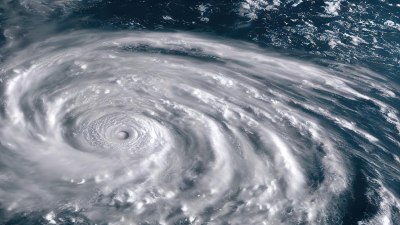Why Hurricanes Spin Differently
Discover the reasons why hurricanes spin differently in various regions of the world.

Image by studioworkstock on Freepik
Hurricanes are some of nature's most powerful phenomena, yet their behavior can vary significantly based on a multitude of factors. Understanding why hurricanes spin differently—not just in terms of their direction but also their intensity and structure—requires delving into the intricate interplay of atmospheric conditions, ocean currents, and geographical positioning. In this article, we will explore the science behind the spinning motion of hurricanes, examining how these factors influence their paths and characteristics while providing insights into the global impact of these storms.
Understanding the Basics of Hurricanes
Before diving into why hurricanes spin differently, it's essential to grasp the basic structure and function of a hurricane. A hurricane, or tropical cyclone, forms over warm ocean waters, typically between 5° to 20° latitude. As the warm, moist air rises, it creates a low-pressure system that draws in air from surrounding areas, leading to a continuous cycle of warm air rising and cooler air filling in, establishing the characteristic circulation.
Factors Influencing Hurricane Spin
The spin of hurricanes is primarily influenced by the Coriolis effect, the result of the Earth's rotation. This effect causes moving air to turn and twist—right in the Northern Hemisphere and left in the Southern Hemisphere—leading to the counterclockwise rotation of hurricanes above the equator and the clockwise spin below it. However, the Coriolis effect alone does not dictate the behavior of hurricanes; various other factors come into play, shaping their dynamics and trajectories.
The Coriolis Effect
The Coriolis effect is crucial in shaping the spin and direction of hurricanes. When air moves towards lower pressure areas such as the center of a storm, it is deflected by the Earth's rotation. In the Northern Hemisphere, this deflection causes hurricanes to spin counterclockwise. Conversely, in the Southern Hemisphere, the deflection causes a clockwise rotation. This fundamental principle is foundational in understanding the broader patterns of storm movement.
Ocean Temperature
One of the most critical contributors to the spin and intensity of a hurricane is the temperature of the ocean water where the storm develops. Warm ocean waters, typically at least 26.5 degrees Celsius (about 80 degrees Fahrenheit), act as fuel for hurricanes. As warm water evaporates, it releases heat into the atmosphere, allowing the formation of thunderstorm systems that can coalesce into a hurricane. The availability and distribution of warm water impact the storm's strength and stability.
Wind Shear
Wind shear—the change in wind speed and direction with altitude—can significantly influence hurricane formation and behavior. High wind shear can disrupt the organization of a hurricane by tilting the storm structure. For instance, if strong winds blow in different directions at varying altitudes, it can inhibit the development of a well-defined circulation system necessary for a hurricane to thrive. Low wind shear, on the other hand, promotes a more robust and vertical structure, crucial for hurricane intensification.
Atmospheric Conditions
In addition to ocean temperature and wind shear, other atmospheric conditions impact hurricane spin. The presence of high-pressure systems can steer hurricanes along different paths. For example, when a high-pressure system is positioned to the north of a hurricane, it can push the storm towards the west or southwest. Conversely, if a low-pressure system is nearby, it may allow the hurricane to move more freely in a different direction.
Geographical Influences
The geographical position also plays a significant role in hurricane behavior. Hurricanes can be affected by land masses, ocean currents, and other regional features. For instance, when a hurricane approaches land, it often encounters friction, which weakens the storm and alters its structure. Similarly, ocean currents can guide a hurricane's path, affecting its trajectory and intensity.
Seasonal Variations
Seasonal variations additionally contribute to why hurricanes spin differently. The Atlantic hurricane season spans from June 1 to November 30, during which warmer ocean temperatures facilitate hurricane formation. Conversely, in the Southern Hemisphere, the cyclone season occurs between November and April, impacted by seasonal changes in ocean temperatures and atmospheric conditions. These seasonal shifts can lead to variations in hurricane frequency, intensity, and paths.
Regional Differences
Regions around the world exhibit distinct hurricane characteristics due to local climatic and environmental conditions. For instance, hurricanes in the Atlantic tend to be more massive and intense compared to their counterparts in the Pacific. The warm waters of the North Atlantic, combined with unique atmospheric conditions, create a conducive environment for powerful storm systems, making it a hotspot for hurricane activity.
Impact of Climate Change
The effects of climate change on hurricane characteristics are a growing area of concern. Research suggests that warmer ocean temperatures may lead to more intense hurricanes, as warm water serves as energy for these storms. Additionally, changes in wind patterns and sea level rise can further influence how hurricanes spin and their potential impact on coastal communities. The link between climate change and hurricane behavior underscores the urgent need for further research and understanding of these patterns.
Predicting Hurricane Behavior
With the complexities surrounding hurricane formation and movement, predicting their behavior is a challenge. Meteorologists utilize advanced technology and modeling techniques to forecast hurricane paths and intensity. Data from satellites, ocean buoys, and weather stations are collected and analyzed to provide a comprehensive view of atmospheric conditions. Despite advanced prediction models, the inherent unpredictability of hurricanes remains a hurdle, necessitating ongoing research and refinement of predictive methods.
Preparedness and Safety
Understanding why hurricanes spin differently is not only essential for meteorological research but also for public safety and preparedness. Communities in hurricane-prone regions are encouraged to develop contingency plans, based on accurate forecasts and forecasts of the expected behavior of storms. Awareness campaigns and timely alerts can save lives as individuals and families prepare for the potential impact of hurricanes.
In conclusion, the spinning motion of hurricanes is influenced by a combination of the Coriolis effect, ocean temperatures, wind shear, atmospheric conditions, geographical features, and seasonal variations. Each hurricane presents a unique set of circumstances that dictate its behavior, making the study of these storms a complex yet fascinating area of research. As climate change continues to reshape our environment, understanding these factors becomes increasingly crucial for both prediction and preparedness. By grasping the science behind hurricanes, we can better equip ourselves for the challenges posed by these powerful storms.











